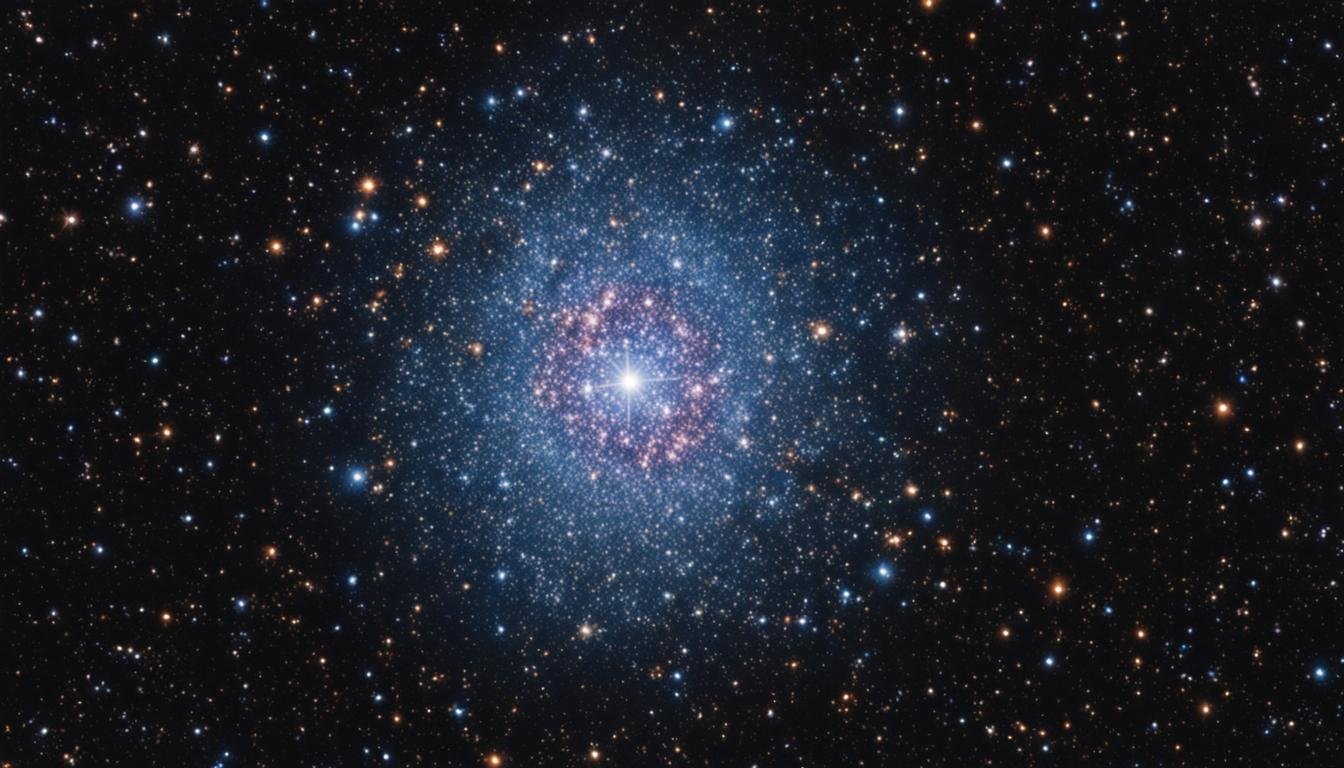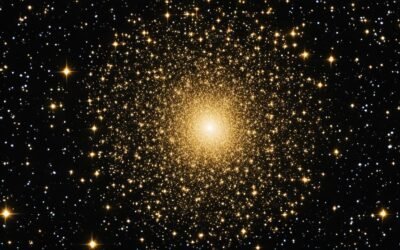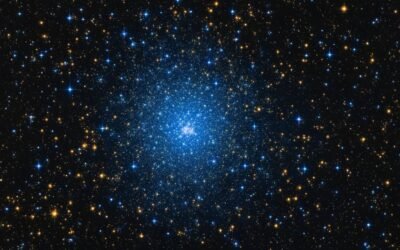Welcome to the world of Messier objects, where celestial wonders await your exploration. In this article, we will delve into the intriguing realm of Messier 9, also known as M9 or NGC 6333. This globular cluster, located in the constellation of Ophiuchus, is a captivating celestial entity that has caught the attention of astronomers for centuries.
Discovered by Charles Messier on June 3, 1764, Messier 9 resides approximately 25,800 light-years away from Earth. It is nestled in the southern part of Ophiuchus, perched atop the enigmatic dark cloud known as Barnard 64.
Characterized by its faint yet mesmerizingly beautiful glow, Messier 9 boasts an apparent magnitude of 7.7 and an angular size of 9.3 arcminutes. With a mass of 4.22×105 solar masses and a radius of 45 light-years, this globular cluster is a stunning testament to the vastness and complexity of our universe.
Key Takeaways:
- Messier 9, also known as M9 or NGC 6333, is a globular cluster located in the constellation of Ophiuchus.
- Discovered by Charles Messier in 1764, Messier 9 is positioned atop the dark cloud Barnard 64.
- Messier 9 has an apparent magnitude of 7.7 and an angular size of 9.3 arcminutes.
- With a mass of 4.22×105 solar masses and a radius of 45 light-years, Messier 9 is a remarkable celestial object.
- Exploring Messier 9 provides insight into the intricacies of globular clusters and the captivating nature of our universe.
The Discovery and Characteristics of Messier 9
Messier 9, also known as M9 or NGC 6333, was discovered by Charles Messier in 1764. Initially described as a “nebula without stars,” it was later resolved into individual stars by William Herschel in 1783.
M9 is located in the constellation of Ophiuchus and is one of the nearer globular clusters to the center of our galaxy, the Milky Way. With a faint light and a diameter of approximately 3 arcminutes, it presents a captivating sight in the night sky.
The globular cluster is composed of a myriad of minute stars, clustering into a dense core region. Its classification as a Class VIII globular cluster and a metallicity of -1.77 dex contribute to its unique characteristics.
“Messier 9 is a remarkable cluster, showcasing the beauty and complexity of our universe. Its discovery and subsequent exploration have deepened our understanding of stellar populations and globular clusters.”
Messier 9 Characteristics
Let’s take a closer look at the characteristics of Messier 9:
| Characteristic | Value |
|---|---|
| Discovery | Charles Messier, 1764 |
| Location | Constellation Ophiuchus |
| Distance from Earth | 25,800 light-years |
| Diameter | Approximately 3 arcminutes |
| Classification | Class VIII globular cluster |
| Metallicity | -1.77 dex |
Understanding the discovery and characteristics of Messier 9 opens up a world of knowledge and wonder about the vastness of the universe and the intricate formations that exist beyond our planet.
The Composition and Size of Messier 9
Messier 9, also known as M9 or NGC 6333, is a fascinating globular cluster with unique characteristics. It consists of more than 250,000 stars, concentrated towards its center. The cluster has a slightly flattened shape, influenced by the gravitational pull of the Milky Way’s core.
The stars within Messier 9 are predominantly red giants and blue horizontal branch stars, contributing to its distinct composition. With a total luminosity approximately 120,000 times that of the Sun and an absolute magnitude of -8.04, M9 shines brightly in the night sky.
The size of Messier 9 is equally impressive. Spanning approximately 90 light-years, this globular cluster captures the imagination with its immense scale. The core region of M9 occupies about 5 arcminutes, providing a compact center amidst its vast expanse of stars.
| Composition | Size |
|---|---|
| Mainly red giants and blue horizontal branch stars | Approximately 90 light-years, core region: 5 arcminutes |
The Location and Distance of Messier 9
Messier 9, also known as M9 or NGC 6333, is positioned in the constellation of Ophiuchus. Its coordinates are approximately 17h 19m 11.78s right ascension and -18° 30′ 58.5″ declination. This globular cluster is located towards the southwest of the star Eta Ophiuchi, about 3 degrees southeast of it.
Messier 9 is relatively close to the center of the Milky Way, with a distance of 25,800 light-years from Earth. Its proximity to the galactic core affects its shape and motion, showcasing the influence of the Milky Way on the cluster’s morphology.
Observing Messier 9 provides a unique opportunity to study the characteristics of a globular cluster situated in close proximity to the galactic center. Its location and distance make it a fascinating object for astronomers to explore and better understand the nature of stellar populations within globular clusters.
History of Observation of Messier 9
Messier 9, also known as M9 or NGC 6333, has a rich history of observation dating back to its discovery by Charles Messier on May 28, 1764. However, Messier initially mistook it for a nebula without stars. It wasn’t until 1783 that William Herschel, using his powerful reflector telescope, was able to resolve the individual stars within the cluster.
Since its discovery, Messier 9 has been the focus of numerous observations by astronomers worldwide. These observations have greatly contributed to our understanding of globular clusters and stellar populations.
By studying Messier 9 and its stellar content, astronomers have been able to delve deeper into the intricate nature of globular clusters. They have examined the cluster’s composition, structure, and behavior, shedding light on the processes that govern the formation and evolution of these dense stellar systems.
Observations of Messier 9 have also provided valuable insights into the overall distribution of stars within our galaxy, the Milky Way. By studying its characteristics and position, astronomers have gained a better understanding of the galactic ecosystem and the role of globular clusters within it.
“Observations of Messier 9 have played a vital role in advancing our knowledge of globular clusters and their place in the cosmos. They have provided invaluable data for studying the formation and evolution of stars, as well as the dynamics of galaxies.”
By continuously observing Messier 9 and collecting data over the years, astronomers have been able to refine their models and theories, fueling further advancements in our understanding of the universe.
Messier 9 Observations Contributions:
- Redefined our understanding of globular clusters
- Provided insights into stellar populations and stellar evolution
- Contributed to studies of galactic dynamics and structure
- Improved models of stellar formation and evolution
- Deepened our understanding of the Milky Way galaxy
| Year | Observatory/Astronomer | Key Observations |
|---|---|---|
| 1764 | Charles Messier | First observation, mistook M9 for a nebula without stars |
| 1783 | William Herschel | Resolved individual stars within Messier 9 |
| 19th – 20th Century | Various observatories and astronomers | Continued observation and documentation of M9’s properties |
Thanks to the dedicated efforts of astronomers past and present, Messier 9 continues to be a valuable object of study, providing insights into the mysteries of the universe.
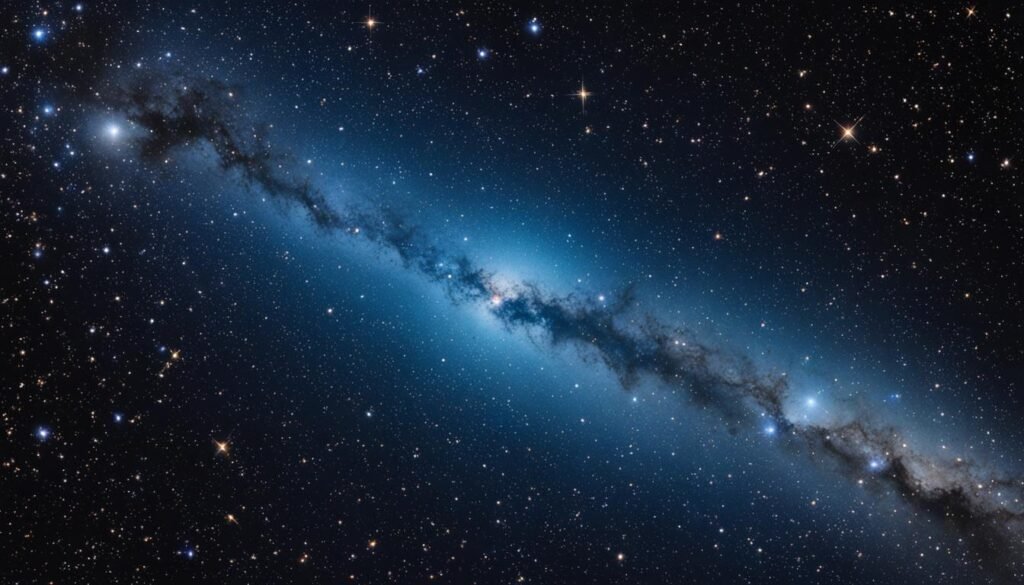
Viewing Messier 9
Messier 9, a captivating globular cluster, can be observed using a small telescope. When viewed through binoculars or smaller telescopes, it appears as a small, round, and faint nebula. However, with larger telescopes, the central region of the cluster becomes more visible, revealing a concentrated core surrounded by a collection of stars.
To fully appreciate the beauty of Messier 9, it is best observed during the months of May, June, and July. During this time, the cluster is ideally positioned in the sky for observation.
The location of Messier 9 is approximately 3 degrees southeast of the star Eta Ophiuchi. By directing your gaze slightly towards the southeast, you can easily locate this intriguing celestial object.
| Observation Details | |
|---|---|
| Apparent Magnitude | 7.7 |
| Best Observation Months | May, June, July |
| Telescope Size | Small telescopes and larger |
| Observation Difficulty | Easy to moderate |
Take the opportunity to observe Messier 9 and immerse yourself in the wonder of this extraordinary globular cluster!
Messier 9 and Stellar Variability
Messier 9, a fascinating globular cluster in the constellation of Ophiuchus, showcases a variety of stellar variability within its celestial boundaries. Within this cluster, astronomers have observed a total of 13 variable stars, each with its own unique characteristics and behavior. These variable stars offer valuable insights into the dynamic nature of stellar populations and astrophysical processes at play within Messier 9.
RR Lyrae Variables
Of the 13 variable stars in Messier 9, 21 belong to the RR Lyrae class. RR Lyrae variables are pulsating stars that exhibit regular changes in brightness, with periods typically ranging from a few hours to a day. These stars are characterized by their stable pulsation periods, which make them valuable tools for measuring distances to globular clusters and determining their ages.
Long-Period Variable
Messier 9 also hosts one long-period variable star. Long-period variables, also known as LPVs, are cool, evolved stars that undergo irregular changes in brightness over long timescales, ranging from several days to thousands of days. These stars are in advanced stages of their evolution, with pulsations driven by complex internal processes.
Type II Cepheid
Within Messier 9, there is one Type II Cepheid variable star. Type II Cepheids are pulsating stars that exhibit regular changes in brightness, similar to RR Lyrae variables. However, Type II Cepheids are typically more luminous and have longer pulsation periods, ranging from a few days to a few weeks. These stars play a crucial role in distance measurements and stellar population studies.
Eclipsing Binary
In addition to the pulsating stars, Messier 9 is home to an eclipsing binary system. Eclipsing binaries consist of two stars that orbit each other in such a way that their orbital plane is aligned with Earth. As a result, one star periodically passes in front of the other, causing a temporary decrease in brightness. These systems provide valuable information about stellar masses, sizes, and orbits.
| Variable Star Type | Number of Stars |
|---|---|
| RR Lyrae | 21 |
| Long-Period Variable | 1 |
| Type II Cepheid | 1 |
| Eclipsing Binary | 1 |
The presence of these variable stars within Messier 9 underscores the importance of studying stellar variability in understanding the complex processes occurring within globular clusters. By analyzing their pulsation periods, brightness changes, and other characteristics, astronomers can unravel the mysteries of stellar evolution, the ages of globular clusters, and the history of our universe.
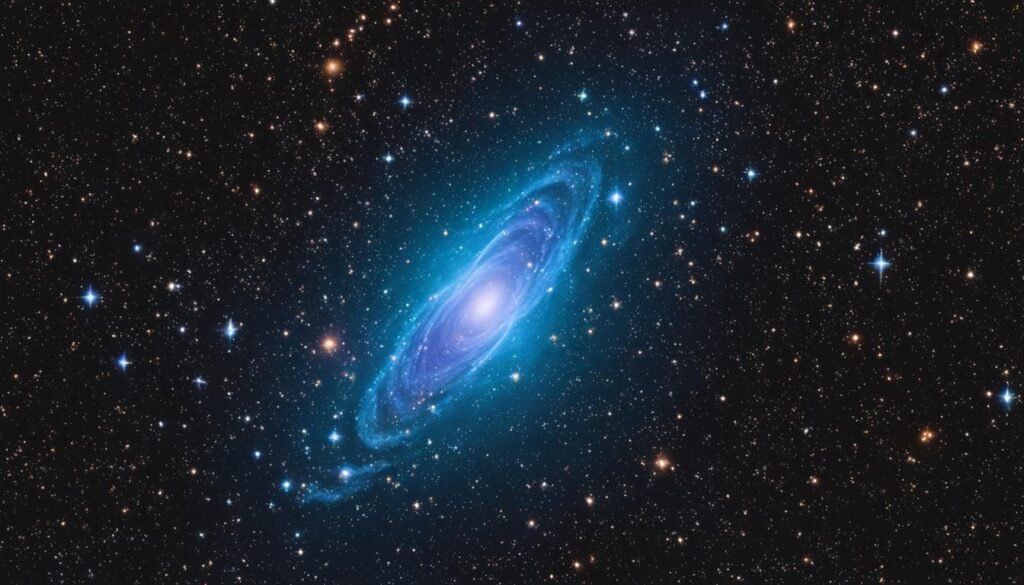
Dark Nebulae Around Messier 9
Messier 9, a captivating globular cluster in the constellation of Ophiuchus, is enveloped by the presence of two remarkable dark nebulae. These dark clouds of interstellar dust, designated Barnard 64 and Barnard 259, cast their shadow on the cluster, contributing to its mysterious allure.
Located directly atop Messier 9, Barnard 64 obscures a portion of the cluster’s light, diminishing its apparent brightness. This interstellar dust cloud adds an element of intrigue, enhancing the fascination of observing Messier 9.
To the southeast of the cluster lies Barnard 259, another dark nebula that partially masks the light emitted by Messier 9. Its position relative to the cluster creates an intriguing visual contrast, further captivating astronomers and stargazers alike.
The interplay between Messier 9 and these dark nebulae reveals the dynamic nature of the cosmos, as interstellar dust clouds provide a captivating backdrop for the luminous beauty of globular clusters.
Nearby Globular Clusters to Messier 9
Alongside Messier 9, there are two noteworthy neighboring globular clusters that add to the celestial beauty of the region. The first one is NGC 6356, situated approximately 80 arcminutes northeast of Messier 9. NGC 6356 shines with an apparent magnitude of 8.25 and boasts an apparent diameter of 8 arcminutes. This magnificent cluster showcases the wonders of the cosmos with its collection of stellar treasures.
Another captivating neighbor of Messier 9 is NGC 6342, located about the same distance to the southeast. With an apparent magnitude of 9.7 and a diameter of 3 arcminutes, NGC 6342 is a smaller yet equally alluring globular cluster. Together, these neighboring clusters enhance the celestial landscape, captivating stargazers and astronomers alike.
These neighboring globular clusters stand as a testament to the vastness and diversity of the cosmos, inspiring awe and wonder in all who behold them.
Messier 9 and the Milky Way
Messier 9, a captivating globular cluster, holds a special position in relation to the majestic Milky Way galaxy. Located at a distance of 5,500 light-years from the galactic center, Messier 9 stands as one of the closer globular clusters to this cosmic hub. Its proximity to the galactic center plays a significant role in shaping its unique characteristics and movement.
As we observe Messier 9, we witness how its position within the Milky Way influences its shape and motion. The cluster is currently moving away from us at a velocity of 224 km/s, gradually drifting further from our perspective. This drift allows us to gain valuable insights into the cluster’s dynamic relationship with the galactic center and the forces that shape its trajectory.
To fully comprehend the intricate interplay between Messier 9 and the Milky Way, further research and exploration are essential. By studying this globular cluster’s behavior and its proximity to the galactic center, scientists can unravel deeper secrets of the Milky Way’s grand structure and grasp the larger cosmic patterns at play.
Messier 9’s Journey: Moving Away from the Center
Within the vast expanse of the Milky Way, Messier 9 embarks on its journey, gradually distancing itself from the bustling galactic center. This movement, along with the ever-changing astronomical landscape, provide astronomers with a constant source of discovery and exploration.
By closely monitoring Messier 9’s trajectory, scientists can derive crucial data and unravel the mysteries inherent in the dynamics of globular clusters within galaxies. The detailed analysis of Messier 9’s drift and interaction with the Milky Way allows for a deeper understanding of the forces at work on both local and cosmic scales.
Unveiling the Secrets: Studying Messier 9’s Movement
The motion of Messier 9 and its relationship with the Milky Way serves as a fascinating case study for astronomers. Through thorough observation and analysis, researchers can identify the underlying factors that contribute to the cluster’s unique characteristics and its role within the galactic ecosystem.
By integrating findings from studies focusing on Messier 9’s motion, scientists can create a comprehensive understanding of how globular clusters interact with the larger galactic structure. These insights provide foundational knowledge for unraveling the mysteries of the universe and appreciating the intricate dance of celestial bodies.
As we delve deeper into the exploration of Messier 9 and its connection to the Milky Way, new revelations await us. The captivating nature of globular clusters and their role in galaxy evolution continues to ignite our curiosity and fuel our quest to understand the vast cosmic tapestry we inhabit.
Conclusion
Messier 9, also known as M9 or NGC 6333, is an intriguing globular cluster located in the constellation of Ophiuchus. Its discovery by Charles Messier in 1764 marked the beginning of our exploration into the nature of globular clusters and their stellar populations.
The composition and size of Messier 9 reveal a cluster made up of more than 250,000 stars, with a concentration towards its dense core region. Its flattened shape, influenced by the gravitational forces of the Milky Way’s core, further adds to its unique characteristics.
Located approximately 25,800 light-years away from Earth, Messier 9 offers astronomers and stargazers alike the opportunity to observe its intricate structure and the interstellar environment in which it resides. The cluster’s proximity to the galactic center highlights the influence of our Milky Way on its morphology.
As we continue to study and observe Messier 9, we gain insights into the evolution of globular clusters and the stars within them. By exploring the complexities of this remarkable object, we expand our understanding of the vast universe in which we live.
FAQ
What is Messier 9?
Messier 9, also known as M9 or NGC 6333, is a globular cluster located in the constellation of Ophiuchus. It is a dense grouping of stars that appears as a faint nebula in binoculars and small telescopes.
When was Messier 9 discovered?
Messier 9 was first observed by Charles Messier on May 28, 1764. He initially described it as a “nebula without stars,” but in 1783, William Herschel was able to resolve individual stars within the cluster.
What are the characteristics of Messier 9?
Messier 9 has an apparent magnitude of 7.7 and an angular size of 9.3 arcminutes. It has a mass of 4.22×105 solar masses and a radius of 45 light-years. The cluster is estimated to be 12.0 billion years old and is classified as an Oosterhoff type II globular cluster.
Where is Messier 9 located?
Messier 9 is located in the constellation of Ophiuchus, towards the southwest of the star Eta Ophiuchi. Its coordinates are approximately 17h 19m 11.78s right ascension and -18° 30′ 58.5″ declination. The cluster is positioned about 3 degrees southeast of Eta Ophiuchi.
Can Messier 9 be observed with a telescope?
Yes, Messier 9 can be observed with a small telescope. It appears as a small, round, and faint nebula in binoculars and small telescopes. With larger telescopes, the central region of the cluster becomes more visible, revealing a concentrated core surrounded by a collection of stars.
Are there variable stars in Messier 9?
Yes, Messier 9 contains 13 variable stars. These include 21 RR Lyrae variables, one long-period variable, one Type II Cepheid, and one eclipsing binary.
What are the dark nebulae around Messier 9?
Messier 9 is located near two dark nebulae. Barnard 64 lies atop the cluster, while Barnard 259 is located southeast of the cluster. These dark clouds of interstellar dust partially obscure the light from the cluster, causing it to appear fainter.
Are there any nearby globular clusters to Messier 9?
Yes, there are two nearby globular clusters to Messier 9. NGC 6356 is situated approximately 80 arcminutes northeast of M9, while NGC 6342 is located about the same distance to the southeast.
How does Messier 9 relate to the Milky Way?
Messier 9 is one of the nearer globular clusters to the center of the Milky Way. It is located at a distance of 5,500 light-years from the galactic center. Its proximity to the center influences its shape and motion.



